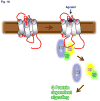Emerging paradigms of β-arrestin-dependent seven transmembrane receptor signaling
- PMID: 21764321
- PMCID: PMC3168679
- DOI: 10.1016/j.tibs.2011.06.003
Emerging paradigms of β-arrestin-dependent seven transmembrane receptor signaling
Abstract
β-Arrestins, originally discovered to desensitize activated seven transmembrane receptors (7TMRs; also known as G-protein-coupled receptors, GPCRs), are now well established mediators of receptor endocytosis, ubiquitylation and G protein-independent signaling. Recent global analyses of β-arrestin interactions and β-arrestin-dependent phosphorylation events have uncovered several previously unanticipated roles of β-arrestins in a range of cellular signaling events. These findings strongly suggest that the functional roles of β-arrestins are much broader than currently understood. Biophysical studies aimed at understanding multiple active conformations of the 7TMRs and the β-arrestins have begun to unravel the mechanistic basis for the diverse functional capabilities of β-arrestins in cellular signaling.
Copyright © 2011 Elsevier Ltd. All rights reserved.
Figures






References
-
- Bjarnadottir TK, Gloriam DE, Hellstrand SH, Kristiansson H, Fredriksson R, et al. Comprehensive repertoire and phylogenetic analysis of the G protein-coupled receptors in human and mouse. Genomics. 2006;88:263–273. - PubMed
-
- Pierce KL, Premont RT, Lefkowitz RJ. Seven-transmembrane receptors. Nat Rev Mol Cell Biol. 2002;3:639–650. - PubMed
-
- Ma P, Zemmel R. Value of novelty? Nat Rev Drug Discov. 2002;1:571–572. - PubMed
Publication types
MeSH terms
Substances
Grants and funding
LinkOut - more resources
Full Text Sources
Other Literature Sources

